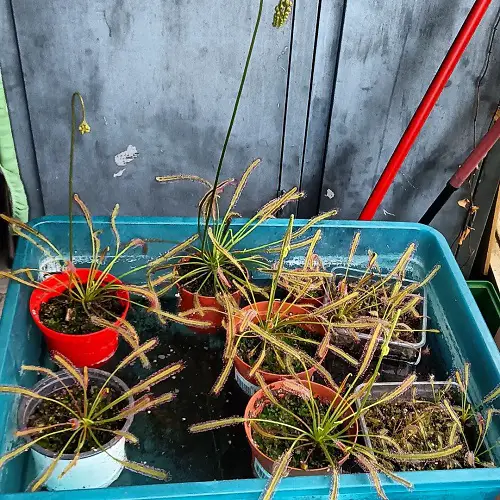Learn how to grow an Octopus Plant with the help of this guide, and include this Carnivorous Plant in your home or garden.

The Octopus Plant, also known as Drosera capensis, is a charming carnivorous specimen native to the Cape region of South Africa. If you want to include this plant in your collection, read the useful tips below.
Botanical Name: Drosera capensis
USDA Zones: 7a-9b
Common Names: Octopus Plant, Cape Sundew
Octopus Plant Information
The plant gets its name from the glistening drops of mucilage on its leaves, which resemble morning dew. The leaves of the Octopus Plant are long and slender, with a reddish tinge at the base and a greenish-yellow color toward the tip.
One of the most unique characteristics of Drosera capensis is its ability to trap and digest insects. The plant uses its leaves to produce sweet-smelling nectar that attracts insects. Once the insect lands on the leaf, it becomes stuck to the sticky droplets on the surface. The plant secretes enzymes to digest the insect, giving it the important nutrients it needs to survive.
Learn How to Grow Carnivorous plants
Pot Size for Growing Octopus Plant
It stays compact; you can start the plant in a 6-8-inch pot, which will be good enough for a long time to come. Depending on the growth and spread, re-pot it into one size bigger container than the old one.
Propagating Octopus Plant
Select a healthy stem with several leaves from a healthy Octopus Plant. Use clean, sharp scissors or a knife to cut a section of the stem just below a node. Remove the lower leaves, leaving a few at the top. Plant the cutting in a suitable propagation medium, such as a mix of sphagnum moss and perlite or a carnivorous plant-specific soil mix. Place the cutting in a humid environment with bright, indirect light. Keep the soil consistently moist but not waterlogged.
After a few weeks, roots should begin to develop. Once the cutting has established roots, it can be transplanted into its own container with appropriate growing conditions.
Pro Tip: Propagating Drosera capensis can be a hit or miss, so it is always a good idea to get a healthy specimen from a garden center.
Octopus Plant Growth Requirements
Sunlight
The Octopus Plant grows well in bright, direct sunlight. It requires at least 6-8 hours of sunlight per day to ensure healthy growth and vibrant coloration.
Place the plant near a south-facing window or under artificial grow lights to provide it with the necessary light intensity.
Soil
These plants prefer a well-draining, acidic soil mix. A recommended mix will be a mixture of sphagnum moss and perlite or sand.
The sphagnum moss helps retain moisture while allowing excess water to drain away, preventing waterlogged conditions that can harm the plant’s roots.
Water
Drosera capensis naturally grows in boggy, wet environments. It requires consistent moisture to thrive. To avoid the minerals present in tap water, you should water Drosera capensis using distilled or rainwater.
Keep the soil moist but not waterlogged, allowing the top layer of the soil to dry slightly between waterings.
Temperature and Humidity.
They prefer warm temperatures between 70-85°F (21-29°C) during the day and slightly cooler temperatures at night.
Octopus plants can tolerate a wide range of humidity levels, but higher humidity (around 50-70%) is ideal for optimal growth. If the air in your home is dry, you can increase humidity by placing Drosera capensis on a tray filled with water or using a humidifier nearby.
Octopus Plant Care
Fertilizer
The Octopus Plant derives most of its nutrients from insects, as it is carnivorous. However, if you want to provide additional nutrients, you can occasionally feed it small insects like fruit flies or ants.
Avoid using traditional fertilizers, which may harm the plant’s delicate roots. It is well-adapted to obtaining its necessary nutrients through its carnivorous nature.
Pruning
Pruning requirements for the Octopus Plant are minimal. You can gently pull away dead or withered leaves to help maintain the plant’s appearance and prevent the buildup of decaying matter that may attract pests or diseases.
Pest and Diseases
These plants are generally resistant to most common houseplant pests. However, occasionally, they can be affected by fungus gnats or aphids.
If you notice any signs of pest infestation, such as small flies around Drosera capensis or aphids on the leaves, you can manually remove them using tweezers or use an insecticidal soap solution to control the pests.
Be sure to follow the instructions on the insecticidal soap product carefully to avoid harming the plant.





